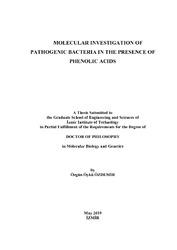Please use this identifier to cite or link to this item:
https://hdl.handle.net/11147/7359| Title: | Molecular Investigation of Pathogenic Bacteria in the Presence of Phenolic Acids | Other Titles: | Fenolik Asitlerin Varlığında Patojen Bakterilerin Moleküler İncelemesi | Authors: | Özdemir, Özgün Öykü | Advisors: | Soyer, Ferda | Keywords: | Pathogenic bacteria Antimicrobial agents Proteomics Phenolic acids Mode of action |
Publisher: | Izmir Institute of Technology | Source: | Özdemir, Ö. Ö. (2019). Molecular investigation of pathogenic bacteria in the presence of phenolic acids. Unpublished doctoral dissertation, Izmir Institute of Technology, Izmir, Turkey | Abstract: | Pathogenic bacteria, including P. aeruginosa, are serious threats for human
health with their antibiotic resistance and virulence factors. Since phenolic acids,
secondary metabolites of plants, can be good candidates as antimicrobial agents, their
mode of action should be investigated. Proteomics is one of the main approaches for
elucidating the mode of action of such compounds. In addition, in order to enhance the
antimicrobial effects and stabilities of phenolics, they can be encapsulated into
nanoparticles. The nanoparticles can be produced from chitosan and alginate which are
biocompatible polymers. In this study, the antimicrobial effects of 3-HPAA and 4-HBA
were presented with MIC values of 2.1 and 1.9 mg/ml, respectively. The bacteriocidal
effects of them were also shown as 2.3 mg/ml for 3-HPAA and 2.1 mg/ml for 4-HBA.
The morphological changes of bacteria were determined after phenolic acid exposure
via SEM. The LC-ESI-MS/MS technique was used to show changes in the protein
profile of bacteria arose from antimicrobial effects. Both phenolic exposures resulted in
various protein changes especially in membrane-related proteins as well as ribosome
and protein synthesis related-proteins. In addition, they caused serious oxidative stress
depending on the protein profile changes related to redox proteins. Alginate-chitosan
nanoparticles resulted increased antimicrobial effects of the phenolics which were
produced, characterized and tested on various pathogenic bacteria via agar diffussion
and spectrophotometric measurements. Hence, free or encapsulated forms of phenolic
acids were demonstrated as effective antimicrobial agents and based on proteomic
results, the effect of phenolic acids may be multi targetted. P. aeruginosa’nın da içinde bulunduğu patojen bakteriler antibiyotik dirençlilikleri ve virülans faktörleri nedeniyle insan sağlığı için önemli bir tehdit oluşturmaktadır. Bitkilerin sekonder metabolitleri olan fenolik asitler antimikrobiyal madde olmak için iyi adaylar olduklarından, etki mekanizmalarının çalışılması gereklidir. Proteomik çalışmalar, böyle maddelerin etki mekanizmalarının araştırılmasındaki önemli yaklaşımlardan biridir. Bunun yanısıra, kararlılıklarının ve antimikrobiyal etkilerinin arttırılması için, fenolik asitler nanopartiküller içerisine hapsedilebilirler. Nanopartiküller, biyo-uyumlu polimerler olan kitosan ve aljinattan sentezlenebilirler. Bu çalışmada, 3-HPAA ve 4-HBA’nın antimikrobiyal etkileri, sırasıyla 2.1 and 1.9 mg/ml olan minimum inhibe edici konsantrasyon değerleri ile sunulmuştur. Aynı zamanda bakterisidal etkiye sahip oldukları ise 3-HPAA için 2.3 mg/ml ve 4-HBA için 2.1 mg/ml minimum bakterisidal konsantrasyon değerleri ile gösterilmiştir. Buna ek olarak, bakterilerin morfolojilerinde fenolik asit uygulamasından sonra oluşan değişiklikler de taramalı elektron mikroskobu ile tespit edilmiştir. LC-ESIMS/ MS tekniği, antimikrobiyal etkiler nedeniyle protein profilinde oluşan değişiklikleri göstermek için kullanılmıştır. İki fenolik muamelesi de bakterinin protein profilinde, zarla ilgili proteinlerdeki, ribozom ve protein senteziyle ilgili proteinlerdeki değişimler başta olmak üzere, birçok değişime neden olmuştur. Bunun yanında, redox proteinlerindeki değişimler göz önüne alındığında, fenoliklerin bakterilerde ciddi oksidatif strese yol açtığı görülmüştür. Fenolik asitlerin enkapsüle edilmesini sağlayan, sentezlenen, tanımlanan ve antimikrobiyal etkileri birçok patojen bakteride agar difüzyon ve spektrofotometrik ölçümlerle test edilen aljinat-kitosan nanopartiküller ise, fenoliklerin antimikrobiyal etkilerinin artmasını sağlamıştır. Bu çalışmayla fenolik asitlerin hem serbest, hem de enkapsüle edilmiş hallerinin etkili antimikrobiyal maddeler oldukları sunulmuş ve proteomik çalışmanın sonuçlarına göre fenolik asitlerin çoklu-hedefli etkiler gösteriyor olabildikleri sonucuna varılmıştır. |
Description: | Thesis (Doctoral)--Izmir Institute of Technology, Molecular Biology and Genetics, Izmir, 2019 Includes bibliographical references (leaves: 176-198) Text in English; Abstract: Turkish and English |
URI: | https://hdl.handle.net/11147/7359 |
| Appears in Collections: | Phd Degree / Doktora |
Files in This Item:
| File | Description | Size | Format | |
|---|---|---|---|---|
| T002019.pdf | DoctoralThesis | 18.38 MB | Adobe PDF |  View/Open |
CORE Recommender
Page view(s)
276
checked on Apr 21, 2025
Download(s)
334
checked on Apr 21, 2025
Google ScholarTM
Check
Items in GCRIS Repository are protected by copyright, with all rights reserved, unless otherwise indicated.